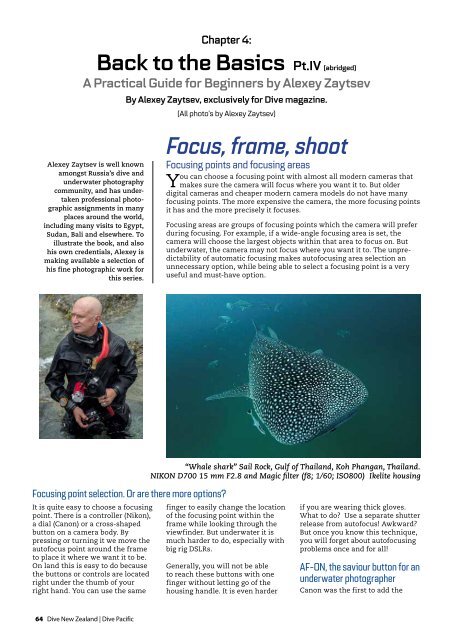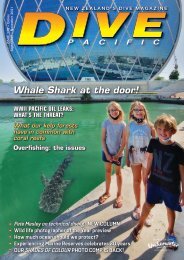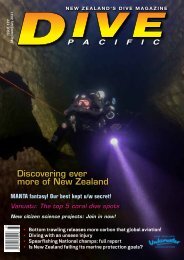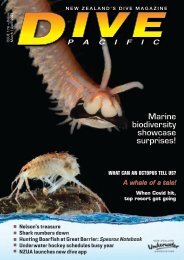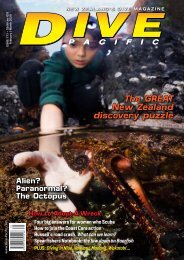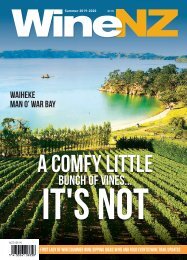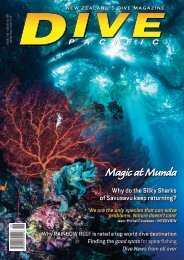Dive Pacific Iss 171 Oct- Nov 2019
New Zealand's dive magazine featuring in this issue: Shooting big sharks, up close; Spearfishing at night!; Remembering a great Kiwi dive pioneer, Wade Doak; Forgotten Vanuatu wreck's claim to fame; The invasive Lionfish - in depth, plus all our expert columnists
New Zealand's dive magazine featuring in this issue: Shooting big sharks, up close; Spearfishing at night!; Remembering a great Kiwi dive pioneer, Wade Doak; Forgotten Vanuatu wreck's claim to fame; The invasive Lionfish - in depth, plus all our expert columnists
Create successful ePaper yourself
Turn your PDF publications into a flip-book with our unique Google optimized e-Paper software.
Chapter 4:<br />
Back to the Basics Pt.IV (abridged)<br />
A Practical Guide for Beginners by Alexey Zaytsev<br />
By Alexey Zaytsev, exclusively for <strong>Dive</strong> magazine.<br />
(All photo's by Alexey Zaytsev)<br />
Alexey Zaytsev is well known<br />
amongst Russia’s dive and<br />
underwater photography<br />
community, and has undertaken<br />
professional photographic<br />
assignments in many<br />
places around the world,<br />
including many visits to Egypt,<br />
Sudan, Bali and elsewhere. To<br />
illustrate the book, and also<br />
his own credentials, Alexey is<br />
making available a selection of<br />
his fine photographic work for<br />
this series.<br />
Focus, frame, shoot<br />
Focusing points and focusing areas<br />
You can choose a focusing point with almost all modern cameras that<br />
makes sure the camera will focus where you want it to. But older<br />
digital cameras and cheaper modern camera models do not have many<br />
focusing points. The more expensive the camera, the more focusing points<br />
it has and the more precisely it focuses.<br />
Focusing areas are groups of focusing points which the camera will prefer<br />
during focusing. For example, if a wide-angle focusing area is set, the<br />
camera will choose the largest objects within that area to focus on. But<br />
underwater, the camera may not focus where you want it to. The unpredictability<br />
of automatic focusing makes autofocusing area selection an<br />
unnecessary option, while being able to select a focusing point is a very<br />
useful and must-have option.<br />
“Whale shark” Sail Rock, Gulf of Thailand, Koh Phangan, Thailand.<br />
NIKON D700 15 mm F2.8 and Magic filter (f8; 1/60; ISO800) Ikelite housing<br />
Focusing point selection. Or are there more options?<br />
It is quite easy to choose a focusing<br />
point. There is a controller (Nikon),<br />
a dial (Canon) or a cross-shaped<br />
button on a camera body. By<br />
pressing or turning it we move the<br />
autofocus point around the frame<br />
to place it where we want it to be.<br />
On land this is easy to do because<br />
the buttons or controls are located<br />
right under the thumb of your<br />
right hand. You can use the same<br />
finger to easily change the location<br />
of the focusing point within the<br />
frame while looking through the<br />
viewfinder. But underwater it is<br />
much harder to do, especially with<br />
big rig DSLRs.<br />
Generally, you will not be able<br />
to reach these buttons with one<br />
finger without letting go of the<br />
housing handle. It is even harder<br />
if you are wearing thick gloves.<br />
What to do? Use a separate shutter<br />
release from autofocus! Awkward?<br />
But once you know this technique,<br />
you will forget about autofocusing<br />
problems once and for all!<br />
AF-ON, the saviour button for an<br />
underwater photographer<br />
Canon was the first to add the<br />
64 <strong>Dive</strong> New Zealand | <strong>Dive</strong> <strong>Pacific</strong>


